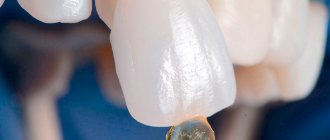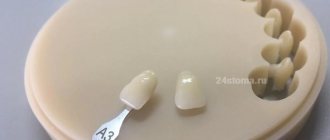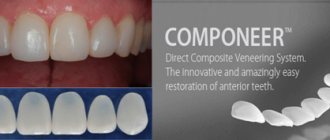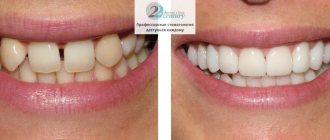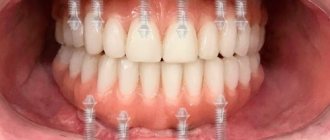Do you dream of a flawless Hollywood smile? Do you want your teeth to be perfectly straight and white, like those of Insta stars and celebrities? This is possible, and even for a very reasonable budget. At the 32 Dent clinic, you can completely restore your teeth using high-quality and modern veneers. Just a couple of visits to the dentist’s office - and you will get the same result that will pleasantly impress you and those around you!
Veneers are thin overlays 0.2 - 0.7 mm thick, which are fixed to the outer surface of their teeth using a special adhesive. They can also be called microprostheses, plates, prostheses, but the essence does not change. This is the most effective method in a couple of visits to the dentist to transform unaesthetic teeth into absolute perfection in color, shape and transparency!
This is interesting! The very first dental veneers appeared at the beginning of the 20th century in the USA, and they were intended for Hollywood stars (hence the phrase “Hollywood smile”). Initially, these were unnaturally white and rough in structure ceramic plates of impressive thickness, which made their teeth larger - it was visually noticeable that there were dentures in the mouth.
Modern designs are more advanced, but at the same time they look natural and aesthetically pleasing. You can easily verify this by looking at examples of the work of doctors at the 32 Dent clinic. The result will impress you!
Who is recommended for veneers and who is not?
In principle, any patient can get dental veneers if they have the funds and the desire. Most often, veneers are installed on teeth for the following reasons:
- not satisfied with the natural color of your teeth;
- there are stains or microcracks on the tooth surface that you want to disguise;
- if there are three (small distances a few millimeters wide);
- in cases where teeth are prone to increased wear at the edges;
- if there are minor orthodontic defects, for example, the tooth is slightly rotated, or mild crowding is diagnosed.
Note!
Even the most modern whitening technologies are not able to give tooth enamel such impeccable whiteness as microprostheses. That is why more and more patients are inclined to install veneers and make their dream of incredibly beautiful teeth come true! Like any restoration procedure, the installation of veneers has its contraindications. It will not be possible to install dental microprostheses if:
- the patient suffers from bruxism - otherwise, microprostheses will constantly break;
- when your teeth are loose and in poor condition, prosthetics will help here (possibly together with implantation);
- if the enamel thickness is insufficient or it is destroyed, then the microprosthesis will not hold;
- the teeth are naturally underdeveloped, too small - the structures simply will not be fixed on the surface;
- there are acute diseases of the ENT organs, problems with the heart and blood vessels, tumors, etc.
Relative contraindications are problems with bite and caries - these issues can be treated, and only after that you can work on the aesthetics of your smile.
Note! If a tooth has been restored by more than 60%, it has a large filling, and it is not advisable to install onlays on it. This can lead to subsequent destruction of the crown, and the patient will already spend a considerable amount on the installation of dental microprostheses. Perhaps in this case, prosthetics at the 32 Dent clinic will help.
How to navigate the names
When choosing records, first of all look at:
- material – ceramics, zirconium, plastic, composite;
- thickness – the method of preparing a dental unit depends on it; the thinner the model, the less turning;
- manufacturer - give preference to a well-known brand whose products are reliable, safe, and time-tested.
In most cases, onlays are placed in the smile area - on the incisors, canines, and premolars. But they can also be fixed to molars. If the tooth is severely damaged, the standard option is not suitable. In this case, the product is installed 180° or 360°, covering the crown on all sides.
What is a classic veneer
This is the name for plates that are fixed only at the front. To attach them, the tooth is ground down, removing the enamel and part of the dentin (hard tissue). This is explained by the fact that:
- The structure of the enamel prevents high-quality adhesion, so it must be removed.
- Dentin needs to be prepared if the thickness of the plate is more than 0.5 mm. Otherwise, the bite will be disrupted, the shape of the face will change, and the patient will feel discomfort.
When you don’t want to sharpen your incisors, canines and molars too much, take lumineers. To fix them, only the enamel is removed.
What you need to be prepared for when deciding to install veneers on your teeth
Unfortunately, patients are not always aware of all the points associated with these structures.
- The crown must first be ground. In most cases, when installing veneers, the enamel must be prepared (remove a microscopic layer) - otherwise, the overlay will stick out and provoke an unattractive effect. But in this case, you can choose an alternative - ultra-thin lumineers, which are attached to the enamel without pre-turning, but at a price - they are much more expensive than conventional onlays.
- Not for life! When deciding one day to put veneers on your teeth, be prepared that in a few years you will have to replace them with new ones. Even the best pads won't last a lifetime. If we are talking about composite veneers, they will have to be replaced after 5 – 7 years.
- Beware of caries! Unfortunately, even the best and well-installed structures do not guarantee that caries will not develop under them. Therefore, experts recommend that patients with veneers monitor their oral hygiene even more carefully and undergo regular preventive examinations in the clinic.
- Pleasure is not cheap. This is not only about the beauty of teeth, but also about the need to invest periodically. So, for example, if one pad breaks or comes off, it will have to be replaced with a new one, which also costs money. However, by investing in your health and beauty, you get much more!
Cost of the procedure
An important aspect is the price of veneers. The cost of one tooth is calculated individually in each specific case and depends on the material from which the onlay is made. The reputation of the orthodontic clinic and the qualifications of the specialist who performs the installation are of great importance.
Price for 1 tooth
Therapeutic designs are also called direct; they are considered cheaper and accessible to most segments of the population. Installation is carried out in one step using simple composites. The procedure is similar to filling. If your teeth need treatment, you will need to visit the orthodontist several times.
The price of one pad depends on the place of residence of the person. So, in Moscow you will have to pay about 5.5 thousand rubles for one veneer. In other regions of Russia, the cost fluctuates around 3 thousand rubles. You can save money on aesthetic dentures in public dentistry or by using promotional offers from private companies.
Prices for orthopedic products vary greatly. This depends not only on the reputation of the medical institution and place of residence, but also on the surface of the dental structures that need to be processed and covered with a plate. Materials also need to be taken into account:
- Glass ceramics - 17 thousand rubles.
- Lumineers - from 32 thousand rubles.
- Ceramics - from 13 thousand rubles.
- Zirconium overlays - from 23 thousand rubles.
At the same time, lumineers and zirconium veneers are not installed in every region due to their high cost. Ceramic structures are the most in demand, so there is a lot of competition for such products.
In some situations, after installing veneers, your gums begin to hurt. There is a possibility that some violations were made during the procedure or the product was installed incorrectly. If discomfort occurs, you should consult a specialist.
Front teeth
Due to the fact that the veneering procedure is necessary to correct the aesthetic characteristics of a smile, veneers are often installed on the 8 lower and 10 upper teeth. In addition, sometimes some elements with damaged enamel or chips are subject to adjustment.
That is why the clinic cannot immediately say specifically how much it costs to install veneers on the front teeth. The price directly depends on the characteristics discussed above (materials, clinic, etc.).
What types of veneers are there? Which is better to choose?
Conventionally, three groups of restoration structures for teeth can be distinguished, if we take into account the specifics of their installation:
- Direct – plates that are installed directly in the dentist’s chair. The specialist first grinds the tooth, after which he applies the composite material layer by layer - by analogy with artistic restoration. As a result, it is possible to obtain a beautiful “new” tooth in shape, color and transparency. The main advantage of direct overlays is their price. The main disadvantage of direct structures is that over time, the composite material still darkens, turns yellow, and the aesthetics are no longer the same.
- Indirect - onlays that are made in advance using impressions taken from the patient’s ground teeth. After the plates are ready, they are tried on the prepared teeth, and then they are fixed using an adhesive composition. While the veneers are being produced in a laboratory, special temporary structures are placed on the patient’s teeth (similar to temporary dentures). The main advantage of indirect solutions is that they are more durable and do not change their color and transparency throughout their entire service life. The main disadvantage of indirect overlays is their high price compared to composite plates.
- Semi-direct – a combination of the two technologies listed above. First, impressions of the patient’s teeth are taken, and new onlays from composite material are made in the dental laboratory. The main advantage of semi-direct veneers is that their fixation to the teeth is considered more reliable. The main disadvantage of semi-direct options is that composite linings still last no more than five years; over time, they will have to be replaced with new ones.
As you can already understand from our examples of clinical cases, dentists distinguish two categories based on the material of manufacture:
- Composite – dental onlays made of filling composite. In some cases, they can be installed without first grinding down your tooth. For example, when there are microscopic cracks in the enamel, or the patient is not satisfied with the shade of the tooth enamel. A thin layer of composite material will mask these moments and allow you to achieve ideal whiteness of your teeth. There will be no visible transitions from the composite composition to the native tissues of the tooth enamel.
- Ceramic – dental plates made from dental ceramics. More advanced solutions in terms of creating ideal tooth shapes. They will help to align and achieve ideal anatomical proportions of teeth, since the structure of the material is as close as possible to the characteristics of natural enamel. At the same time, the price of ceramic analogues is three or even five times higher than the price of classic composite overlays.
Which veneers are best to choose? The question is strictly individual. To answer this, the dentist must:
- assess the condition of the patient’s teeth;
- see the condition of the jaw and exclude serious orthodontic abnormalities;
- find out the goals pursued by the patient who wants to install linings from a particular material;
- roughly be aware of the allocated budget for smile restoration.
It is important! In case of severe curvature of the teeth or pathologies of the jaw, guilt is undesirable. But the patient can always straighten the teeth first and then install veneers to get the picture of their dreams.
As practice shows, ceramic structures are still more preferable. Firstly, this is quality that will prove itself within 20 years. Secondly, it is reliable; teeth will not darken from coffee or cigarettes in a year. Thirdly, if you calculate the budget for installing composite systems every 5 years, then installing ceramic veneers is more profitable from a financial point of view.
Among the most common ceramic veneers, we note 4 directions:
- Zirconium dioxide dental veneers – the main part is made of zirconium alloy, and the top is coated with dental porcelain. They are considered one of the most reliable and durable, but in terms of their tint range and transparency they may be inferior to glass ceramic linings;
- Made from glass ceramics – so-called metal-free plates, which are made in a dental laboratory from pressed glass ceramics. The most popular plates you may have heard of are E Max CAD and E Max Press;
- Porcelain dental veneers are the “gold standard” of designs that combine optimal price and quality. Dental porcelain is the same ceramics, but with characteristics closer to natural enamel;
- Ultra-thin or lumineers are dental onlays approximately 0.02 millimeters thick. They are considered the thinnest, their installation does not require preliminary grinding of the enamel, but their cost is several times more expensive than classic porcelain ones.
Advantages and disadvantages
Every year, the veneering procedure becomes more popular in dentistry. Its demand is due to certain advantages:
- The product covers all tooth surfaces, which minimizes the risk of accidental chips.
- High reliability of the design, which is achieved due to the use of modern materials.
- There is no need to remove the nerve. The exception is cases when inflammatory processes occur in the canals.
- The ability to correct malocclusion or crooked teeth in the early stages without the use of various orthopedic systems or braces that disrupt the aesthetics of the smile.
- The absence of metal elements promotes biological compatibility with tissues. In addition, the risk of allergic reactions is minimized.
- Possibility to choose products to match natural teeth.
- Long period of operation. High-quality systems last 10-15 years.
- The structures are resistant to deformation.
- The color does not change during the entire service life.
- Protecting tooth enamel from damage, exposure to pathological microflora and other negative factors.
- You can install structures both on one tooth and on the entire row.
This procedure has certain disadvantages. Some of them:
- Limited product life.
- The presence of composite materials in the composition that tend to darken and are excessively brittle.
- Increased requirements for oral hygiene.
- High price of products even when installed on 1 tooth.
- Various contraindications.
- There is a risk of changes in diction and discomfort if the teeth are seriously crooked.
- The need to handle veneers with care, as injuries can break the product.
Installation principle for 1 tooth
Installation of veneers: features, important nuances that the patient should know better about
The indirect method involves 3 steps:
- Preparation. First, the tooth enamel is ground down a few tenths of a millimeter - a thin layer of enamel is removed. Then the dentist makes impressions of the patient’s also prepared teeth, after which he covers them with special protective caps - for the period of time while the veneers are produced in the laboratory;
- Visualization. Computer model with “before” and “after” effect. In a 3D program, the dentist creates a virtual model of teeth and clearly demonstrates how it was and how it will be after. The picture is usually impressive and motivating;
- Installation of veneers - your new perfect smile is ready! The dentist fixes the onlays on the tooth enamel, and the patient evaluates the final result.
Installation of microprostheses using the direct method also involves 3 steps:
- Preparation. The dentist removes a small layer of tooth enamel for the patient and prepares the teeth for further restoration;
- Installation of composite structures. Layer by layer, the dentist distributes the composition over the surface of the enamel, while each of them is illuminated with a lamp to “seal”;
- Polishing and finishing to perfection. The enamel surface is carefully polished, the shape of each tooth is brought to perfection.
Veneer care
Oral care remains the same - twice a day. However, the paste should not contain abrasive substances, and the brush should not be hard. If it is not possible to properly clean teeth in hard-to-reach places, it is necessary to regularly visit the dental office for professional cleaning.
Veneers are made of fragile materials (except zirconium), so they should be taken care of. You should not crack seeds, chew nuts, indulge in candy, or eat solid foods (raw carrots, apples). Ceramic can crack easily and can be expensive to replace. Therefore, after installing the pads, your diet should be reconsidered.
Nicotine is well absorbed into any surface, so smoking after installation of veneers is not recommended.
Gum disease can ruin all your efforts to achieve a beautiful smile. If your gums start to bleed, visit your dentist immediately. Bleeding, loose gums will not be able to hold teeth in their sockets and will cause unsteadiness and even loss. Therefore, paying attention to your gums is the key to health and a beautiful smile.
Price question: how much does it cost to install veneers?
As we already said, dental veneers are not cheap, but they are worth it!
Approximate cost of microprostheses:
- Composite ones are the most budget-friendly. The cost of one unit is approximately 7 thousand rubles;
- Ceramic microprostheses, which are manufactured in a dental laboratory, cost approximately 20 thousand rubles per unit;
- Ceramic dental veneers made at the 32 Dent clinic will cost the patient about 15 thousand rubles per unit;
- Lumineers are the most expensive - from 50 thousand rubles per unit.
Installation process
Regardless of the purpose of installation and the type of overlays, the procedure is carried out according to the same algorithm. Main stages:
- Preparatory activities. This includes diagnosing teeth for the presence of fillings that require replacement. This is necessary not only to increase the service life of the products, but also to improve the adhesion of the veneer to the filling material.
- Determining the shade of the overlays. For this purpose, a special scale is used, and the orthodontist considers possible options taking into account the patient’s wishes.
- Enamel polishing. Immediately before installing the onlays, you need to remove a layer 0.5-0.7 mm thick from the outer part of the teeth. The material of old fillings also needs to be ground, the thickness is determined by the dentist depending on the specific case. For high-quality installation, in some situations it is permissible to remove 1.5 mm of enamel.
- Taking impressions for subsequent sending to a dental laboratory.
- Installation of a temporary plastic structure. This is necessary to protect the ground teeth from external irritants.
- The manufacturing process in the laboratory does not involve patient participation. It consists of producing a plaster structure of a certain area of the jaw based on casts, which allows you to make veneers, taking into account all the individual characteristics of a particular maxillofacial apparatus. The production technology depends on the specific material.
- Pre-installation of the product on a special paste. This is a very important step, because different drugs differ in color. The specialist must select them so that the structure acquires the desired color. In most cases, several types of products are mixed so that the products do not differ from natural dental units.
- Final fastening with cement. This is the final stage of work, after which it will be impossible to correct the color or shape of the structure.
Veneers are a fairly simple way to get a beautiful smile. All design flaws and contraindications for use should be taken into account. It is important to note that if a person decides to install dental plates, it will be impossible to return everything back, because the ground units require constant protection with third-party materials. In addition, you should understand that installing veneers is an expensive procedure that not every average person can afford.
How can you save on installing veneers?
There are two ways to go. Place veneers on individual teeth for the patient. For example, for 10 units of the upper jaw - provided that your teeth are in good condition. You can whiten the enamel of your teeth, but the result will not always be perfect.
There is also a solution to take advantage of the favorable conditions of clinics. Thus, 32 Dent dentistry regularly holds promotions and special offers for the installation of veneers. There are opportunities to install dental microprostheses at a discount of 15% to 50%. The quality of work is at the highest level, as are the guarantees.
Alternatives to porcelain veneers
If veneers cannot be placed due to contraindications, dental prosthetics specialists at Amazing Price Dentistry will offer you several alternative solutions.
- If the tooth is too damaged by caries or severely weakened by root canal treatment, a crown is recommended. This will strengthen the tooth and return it to its original shape and functionality.
- If the patient does not have enough teeth in the anterior zone, veneering cannot be used - classic prosthetics or implantation are needed.
- If the malocclusion is severe, then veneers will not cope with the problem, and the frontal zone can be leveled using a brace system (metal, ceramic, lingual).
Separately, it is worth highlighting the method of composite restoration as an alternative to ceramic. This method can restore one tooth, or several problem teeth, but not necessarily the entire frontal area. Therefore, the cost of composite veneering is lower than that of ceramic. But such restoration is less durable than ceramics.
Hit list of questions and answers about veneers
Do veneers ruin your teeth?
Answer: teeth are spoiled by carious lesions, neglect of hygiene rules, lack of regular visits to the dentist, poor nutrition, and bad habits. Veneers, made of first-class material and installed by a professional dentist, on the contrary, protect the enamel from harmful external influences.
Is it painful to install?
Answer: no, it doesn't hurt. The procedure is performed under local anesthesia in a comfortable environment. It is important! There is no need to remove dental nerves during installation.
How long will it take to install?
Answer: on average, from 5 to 14 days or 2 to 3 visits to the dentist’s office.
Dental clinic "32 Dent" specializes in the installation of dental veneers on a turnkey basis. Both budget-class microprostheses and premium solutions are available, including patented American lumineers. Schedule an initial consultation with your doctor to choose the best path to restoring your smile with veneers. The smile will be beautiful and at the same time natural. Take action!
Contraindications and restrictions
Since we objectively consider veneers, with their advantages and disadvantages, we note that they have an important practical disadvantage - they are not suitable for everyone.
Doctors do not recommend installing these microprostheses in the following cases:
- There are no premolars (“sixes”), so there are difficulties with chewing function.
- The bite is seriously deformed.
- The incisor is significantly damaged, and therefore it is difficult (there is nothing) to attach the plate.
- The volume of the filling exceeds 50% - this also reduces the reliability of fixation.
- The patient is interested in martial arts, contact sports, or other activities that can cause jaw injuries.
- A person has bad habits that contribute to the appearance of caries or other diseases, for example, bruxism or a passion for cracking nuts.
In any of these situations, you can use some other restoration option. Moreover, such plates must be worn with caution so as not to damage them.
Life time
Unlike traditional dental panels, composite veneers require renewal every 5 years with proper care.
In addition to the usual daily hygiene procedures using a toothbrush, paste, and thread, composite veneers need polishing. This will require regular visits to the dentist.
To extend the service life of the linings, the plates should not be subjected to rough mechanical stress. To prevent damage to the restoration during sleep, our dentists will recommend protecting the plate at night with a mouthguard and help you choose a suitable design.
Free consultation on the cost of treatment in our dentistry
Leave a request and the clinic administrator will contact you within 15 minutes!
In terms of cost, composite veneers will be the most inexpensive option; the exact cost of making an onlay for one tooth will depend on the production method. The most expensive is a composite veneer created from an individual impression - you will have to pay 10 thousand rubles or more for it.
If you want to save on the cost of installing composite veneers, you can resort to restoration with direct (layer-by-layer) onlays, which are created directly on the patient’s teeth during a visit to the orthodontist. However, cost savings will ultimately be questionable: direct veneers are neither aesthetically pleasing nor durable, and often change their color under the influence of external factors.
Calculate the cost of treatment by taking a short test in 20 seconds!
Do not delay your treatment, because in this matter time plays against us.
Specifics of the production of composite veneers
The easiest way to make composite veneers is to apply a special composition to the surface of the patient’s teeth right in the dentist’s office. During the procedure, the doctor first prepares the enamel coating of the tooth for manipulation by removing a thin layer from it, and then applies the composite in layers to the treated surface. If you are interested in a low price for restoring teeth with veneers, composite structures will be the optimal solution.
Composite veneers are also made from an individual impression of the patient’s teeth, which is taken during an examination in the dentist’s office. An impression is made of the teeth that have been ground for the onlay, and then the technician models the veneer using it. Veneers made from an individual impression are stronger than overlays created by layer-by-layer application.
Reviews
At the moment, dental restoration with veneers using composite materials is quite rare. And yet such cases do occur. Reviews about this method of restoring dental aesthetics are the most contradictory.
- I have suffered from caries since childhood. When the process moved to the front teeth and the fillings became noticeable to others, I consulted a doctor. The dentist suggested using veneers. But, since my salary is small, I had to make a choice in favor of therapeutic pads. The installation was completed in one visit. Together with the doctor, we selected the appropriate color so that the difference in the shade of the enamel would not be visible. The overlay has been in place for 3 years, although it has faded a little.
- There was a chip in the front incisor, and in order to hide the defect, the dentist suggested restoring the tooth with a composite material. The defect was removed quickly, but the appearance of the crown was different from other teeth. It looked a little unnatural. I had to install a ceramic plate.
- Several years ago I had two front teeth restored with composite veneers. The color and appearance of the onlays are no different from my natural teeth. If we're really being picky, the enamel looks less transparent. But this deficiency can also be corrected if you regularly visit the dentist to polish your teeth.
Methods for making ceramic veneers
Ceramic plates are produced using layer-by-layer technology or injection molding. With the layer-by-layer method, the porcelain mass is applied in stages, layer by layer, and then fired to increase its strength and durability. With injection molding, veneers are made under high pressure and temperature, which allows you to obtain finished prostheses of increased strength. If you want to get a reliable and durable result of artistic restoration, we recommend choosing cast veneers.
Both product options are aesthetic and durable, but the useful life of pressed ceramic veneers is significantly longer. The price of porcelain veneers is high and can vary depending on the type of material used in the manufacturing process.
